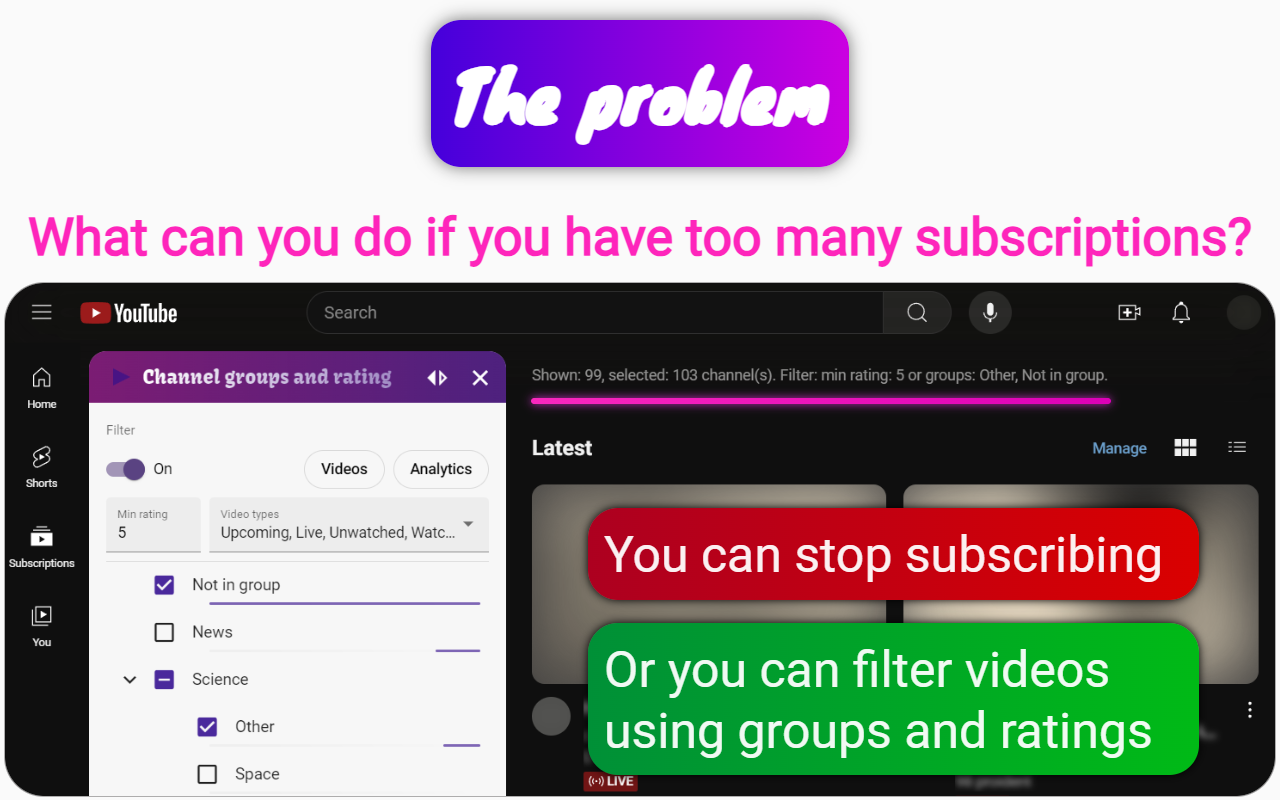How do I organize my YouTube subscriptions into groups or categories?

When we want to organize files, we want to put them in a folder and a subfolder, so under the organization we will represent the creation of groups for YouTube channels, with the ability to filter by them. Groups can be nested in other groups just like folders.
In this case, there are 3 approaches to organizing YouTube subscriptions:
-
Using the RSS feed of the YouTube channel.
Flaw:
- you can only see the latest 15 items in the YouTube RSS feed, which is very few.
-
Using brand YouTube accounts.
Flaw:
- you cannot create a complex hierarchy;
- you cannot combine several topics;
- you have to reload the whole page to change the group, which takes time.
-
Using the browser extension Channel groups and rating.
There are no downsides.
Bonus:
- you can collect YouTube comments in the channel dossier, which will allow you to know exactly why you subscribed to the channel or unsubscribed from it;
- you can organize channels by rating, which allows you to limit the list of videos with one button, this is useful when you want to know the most important things and save time on watching.
This Channel groups and rating extension enhances your YouTube subscription management by enabling you to create nested groups for channels, filter videos by type and rating, and keep track of your reasons for subscribing through comment collection. It provides a seamless way to organize and prioritize your YouTube content efficiently.
Related questions
There are 3 ways to organize YouTube subscriptions in 2021, but I recommend only one of them. By organizing YouTube subscriptions, I mean grouping YouTube channels and filtering videos based on these groups.
Ways I Don't Recommend
- Use an RSS feed aggregator and add the YouTube RSS feed to it.
Disadvantages:
- In the RSS feed of the YouTube channel, there is very little data, only 15 latest items.
- Create a YouTube brand account for each channel topic.
Disadvantages:
- Accounts are presented in the form of a list, but not a tree, so you cannot create a group for a group of channels;
- To move a channel from one group to another, you need to unsubscribe in one account and subscribe in another, this is slow;
- Each group is on a separate page, to merge videos from several topics, you need to create a new account and subscribe to channels;
- Changing the group requires changing the account, which leads to the page reloading, and this requires additional time.
Recommended way
Use a tool specially created for this purpose - the 'Channel groups and rating' browser extension.
Bonuses:
- You can group channels, even those to which you are not subscribed;
- You can collect YouTube comments, which will allow you to create dossiers of channels, it is useful to know when you want to unsubscribe from the channel;
- You can organize channels using the rating, which allows you to limit the list of videos with one button, this is useful when you want to narrow the choice regardless of the topic of the channel;
- Groups are now stored on your own Google Drive, so you don't depend on YouTube.
I'm sure the feature was dropped because YouTube wanted to force users to reduce their subscriptions.
Why?
- The usability only gets worse for those who have subscribed to many channels. Most likely, YouTube doesn't make such mistakes unless there are good reasons.
- Free labor.
YouTube needs to somehow improve the quality of the content, and I think that the viewers themselves participate in this process.
YouTube analytics help bloggers improve their performance. By using subscriptions, you are probably giving less analytics to YouTube.
Why are non-subscription viewers possibly creating more useful data for YouTube?
Because you may be paying more attention to headlines from unfamiliar channels.
Let's say you select a video by title and choose more carefully if you see a channel that you are not subscribed to. If you are subscribed, the title of the video plays less of a role in your decision as you trust your choice in the past.
Let's imagine that you see a header not from your subscriptions and you click on it, and this is analytic data for creators. They learn how to create video titles and images from this data.
Let's say the title deceived you. You would like not to waste time on this channel in the future. If you watched videos from your subscriptions, then you could unsubscribe, but you are watching a channel not from your subscriptions. You will probably spend a lot more time on deceiving tricks of such channels, creating analytic data for YouTube.
If you are wasting your time and it doesn’t bring you pleasure, then it’s like a job that you don’t get paid for.
I believe that the problem is that users are saving time by using subscriptions, but YouTube is getting less data.
How can a user protect himself from imposed work?
YouTube is just a website, to solve this problem, YouTube users can use the extension.
I am grouping YouTube subscriptions, perhaps much better than they were back in 2016. This is possible thanks to the Chrome extension Channel groups and rating.
Now I filter videos by groups and ratings, group subscriptions, and write dossiers for channels. The data is stored on Google Drive, so it is not under the control of YouTube as it used to be.
